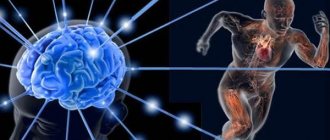Higher mental functions , also called cognitive abilities of the individual, are psychophysiological phenomena that are complex in structure and organization. The processes of higher mental activity are not the result of a person's genetic heritage . They are not given at birth, but are formed throughout life and are a consequence of a person’s individual experience. Their origin and development are determined by cultural and social factors.
All types of human cognitive abilities do not exist in isolation: they are systemically connected with each other. Features of higher mental functions: the possibility and necessity of conscious control of them.
According to modern concepts, human cognitive abilities are based on simple conditioned reflex activity of the brain. This confirms the fact that any mental process is heterogeneous in structure. It occurs in two interconnected planes: on the natural (natural, involuntary, biological) layer and on the acquired (higher, voluntary, cultural) level.
With the help of higher mental functions, a person realizes rational knowledge of the surrounding reality and purposefully interacts with the outside world. Cognitive abilities provide the perception of information, process, synthesize and analyze data, make it possible to remember, store and reproduce information. Thanks to higher mental functions, the subject can exchange information, select the required facts to build a life strategy, and implement a chosen program of action.
Sensory-perceptual disorder
Information about the place of influence of the irritating factor is carried by a sensory image.
Information about the shape, size, and location of the reproduced object in space is carried by a perceptual image. Definition 1
Sensations are the most elementary mental manifestations. They can be perceived either consciously or not. Sensations are the basis of the symptoms of the disease.
During the experiments, it turned out that disorders of the sensory-perceptual sphere can be very diverse in nature: from the inability to recognize simple objects to failure to recognize complex situations.
In patients with different mental disorders, the perception of sensations is also distorted in different ways. For example, some researchers came to the conclusion that in patients with schizophrenia the perceptual function was not impaired. In some cases, the perception function was impaired, and patients were unable to identify a specific object.
Also, a disorder of the sensory-perceptual sphere is observed in patients with auditory and visual hallucinations, with hysterical-depressive syndrome, depressive-paranoid syndrome.
Finished works on a similar topic
- Course work Disorders of mental processes 450 rub.
- Abstract Disorder of mental processes 220 rub.
- Test work Disorder of mental processes 250 rub.
Receive completed work or specialist advice on your educational project Find out the cost
Sensory-perceptual disorders are as follows:
- hyposthesia (decreased sensitivity in different parts of the body, face)
- hypersthesia (painfully increased sensitivity)
- anesthesia (decreased sensitivity up to complete cessation of perception)
- paresthesia (spontaneously occurring sensations, for example, tingling, burning, sometimes synesthesia and senesthopathy)
- illusion (this is a distorted perception, it can be physical, physiological, psychological, pathological)
- hallucination (an image that appears in consciousness without a stimulus)
- pseudohallucination (an image that appears in the mind without a stimulus, but shows objects that do not exist in reality)
- psychological automatism (consists of pseudohallucinations, delusional ideas, alienation of one’s own mental act occurs)
Kinds
Medicine distinguishes several types. Among them:
- pathological – occurs after somatic and mental pathologies;
- disharmonious – congenital or early acquired disproportionality in mental development;
- dysontogenesis – complicated, inhibiting formation;
- degenerative – directly related to various mental illnesses, for example, epilepsy;
- irreparable deviation of consciousness.
In addition, dementia, retardation and asynchrony are distinguished. There are isolated cases, subsequently of which clinical forms are discovered, such as infantilism, autism and somatopathy. There are mild, neurodynamic, analytical and psychopathic forms.
Attention disorder
Note 1
Attention is the process of an individual’s mental activity aimed at certain objects and phenomena. Attention disorder consists either in its weakening or, conversely, in its strengthening.
Too lazy to read?
Ask a question to the experts and get an answer within 15 minutes!
Ask a Question
When attention weakens, the active component of attention deteriorates and the passive component predominates.
Another sign of attention disorder is irritability and poor attention. As a result of this disorder, the active component of attention changes under the influence of external and internal stimuli. In these cases, the person experiences obsessive thoughts.
Due to excessive mental stress, a decrease in attention occurs. In most cases, this is the norm, but if a person gets tired quickly after a short period of work, then we are talking about a pathological condition.
There is also such a pathology as aprosexia, that is, a complete loss of attention. A person cannot direct and fix his attention.
Excessive attention is also considered a pathological condition. In these cases, it is the passive component that is enhanced, while active attention decreases. The extreme manifestation of this disorder is hypermetamorphosis, in which case the patient pays attention to unimportant things, while every small irritant causes a reaction in them.
Symptoms
Symptoms of mental retardation (oligophrenia) are characterized by disorders of emotional functions, as well as significant intellectual disability:
- cognitive needs are impaired or absent;
- perception slows down and narrows;
- there are difficulties with active attention;
- the child remembers information slowly and fragilely;
- poor vocabulary: words are used imprecisely, phrases are undeveloped, speech is characterized by an abundance of cliches, agrammatisms, pronunciation defects are noticeable;
- moral and aesthetic emotions are poorly developed;
- there are no stable motivations;
- the child is dependent on external influences and does not know how to control the simplest instinctual needs;
- difficulties arise in predicting the consequences of one’s own actions.
Thought disorders
A thinking disorder is manifested by a violation of the process of cognition of reality, the formation of conclusions. There is an acceleration or, conversely, a slowdown in the associative process. Associations become broken and incoherent. Symptoms of a thought disorder may include:
- intrusive thoughts
- rave
- super value of ideas
Thinking disorders can be caused by biochemical changes in the brain, for example, as a result of circulatory disorders, intoxication, or disruption of hormones. The cause may be traumatic brain injury, the disorder occurs as a result of damage to the brain. Psychosis and schizophrenia can also cause thinking disorders. Strong emotional stress, depression, anxiety affect thinking, a person is focused on his internal experiences.
Higher mental functions
Perception. The level of analysis and synthesis of what is perceived suffers.
Motor skills. Monotony, irregularity, slowness, poor plasticity. Synkinesis. Instability of muscle tone, awkwardness of voluntary movements, poor facial expressions, gestures, the presence of unnecessary actions, lethargy.
Speech. Usually more impaired than other HMFs, but weaker than intelligence. The function of generalization is poorly reflected in speech; the semantic side suffers. Reduction of active (rougher) and passive vocabulary. The grammatical structure of speech is broken. What they lack in understanding they make up for in execution. A.R. Luria wrote about the violation of the regulatory function of speech (the role of speech in self-regulation).
- Thinking. Intelligence is usually the most affected.
- Personal-motivational level (regulatory function is impaired)
- Operational level (relatively preserved)
- Dynamic aspect (inertia)
- The formation of concepts is difficult, logical schemes are not built (inability to generalize).
- Lack of development of practical intelligence.
- Memory.
- Natural, mechanical memory m.b. better than normal (10 words)
- Interference is increased.
- Semantic organization and mediation reduce the effectiveness of memorization.
- Semantic memory is also impaired.
- Attention.
- Insufficiency, volume reduction.
- Instability.
- Voluntary attention suffers more. Where there is no attention, there is no way. place for wanting (Geller).
Memory disorder
Note 2
Memory disorder is understood as a decrease or complete absence of the function of storing and reproducing information.
There are many reasons why memory loss can occur. When a person is overly physically and emotionally overloaded, he is in a state of stress. As a result, cognitive processes degrade. Memory may decrease due to fasting and lack of sleep. Somatic diseases can also impair memory. As a result of alcoholism and drug addiction, memory loss occurs due to damage to the brain and exposure to toxins. With TBI, memory impairment can be either minor or significant, up to the complete loss of all information. With degenerative processes of the central nervous system, attention disorder also occurs, as there is a decrease in the volume of brain tissue and the number of cells. Mental disorders such as schizophrenia and epilepsy affect memory. With mental retardation, memory impairment occurs.
Symptoms of memory disorders include hypomnesia - a decrease in the ability to store, remember and subsequently reproduce information. A person remembers names, addresses, etc. worse. Amnesia is another type of memory disorder. Amnesia involves complete loss of memory. In this case, information may appear for both the last few hours and the last few days. One of the variants of amnesia is fixed amnesia, in which a person loses the ability to remember current information. Paramnesia is a qualitative memory disorder. It is divided into:
- confabulation (when the patient forgets an event and replaces it with fiction)
- cryptomnesia (the patient believes that the events he read about in a book or saw in a movie happened to him)
- echonesia (false memory)
Types of mental development disorders
Mental development disorders are classified into several types.
The main types of mental development disorders include:
- dysontogenesis, including damaged, delayed and distorted development;
- irreversible mental underdevelopment;
- disharmonious mental development;
- degenerative mental development associated with epilepsy and other diseases;
- pathological mental development caused by mental and somatic pathologies.
They also distinguish types of mental development disorders according to the schizophrenic process: asynchrony, retardation and mental retardation.
In some cases, clinical forms of disorders appear, including acceleration, infantilism, autism and somatopathy.
Separately in medicine, mental development disorders associated with the type of oligophrenia are distinguished - uncomplicated, neurodynamic, analytical and psychopathic forms.
Correction of mental retardation
Working with children with mental retardation requires a multidisciplinary approach and the active participation of pediatricians, child neurologists, child psychologists, psychiatrists, speech therapists, and speech pathologists. Correction of mental retardation should begin in preschool age and be carried out over a long period of time.
Children with mental retardation should attend specialized schools or correctional classes in general education schools. Features of teaching children with mental retardation include the dosage of educational material, reliance on clarity, repeated repetition, frequent change of activities, and the use of health-saving technologies.
When working with such children, special attention is paid to the development of cognitive processes (perception, attention, memory, thinking); emotional, sensory and motor spheres with the help of play therapy, fairy tale therapy, children's art therapy. Correction of speech disorders in mental retardation is carried out by a speech therapist in individual and group lessons. Together with teachers, correctional work on teaching students with mental retardation is carried out by special education teachers, psychologists, and social educators.
Medical care for children with mental retardation includes drug therapy in accordance with identified somatic and cerebral-organic disorders, physiotherapy, exercise therapy, massage, and hydrotherapy.
Diagnostics
The child's behavior may change: his attention is easy to direct; he has difficulty concentrating; he constantly repeats the same actions. At school, such children are restless, their movements are fast and twitching, they constantly grimace; write by pressing hard on the pencil. The intelligence of such children may be normal, but some cognitive components of classes (for example, short-term memory, action planning) are impaired, and their development has slowed down. Various partial disturbances may be detected: speech, movements and orientation. A common disorder in this area is legasthenia (difficulty in learning writing and reading skills).











